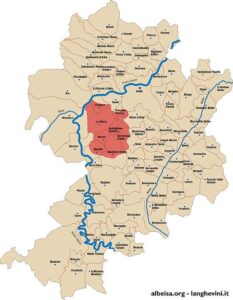Today many of us recognise Barolo as a gorgeous red wine, made notable for the fact that it is bears the prestigious mark of the Denominazione di Origine Controllata e Garantita (DOCG), which guarantees a certain level of quality.
What you may not know is that the wine itself takes its name from a region in the north of Italy and that the history behind the wine is almost as intriguing as the rich taste of the drink itself.
The origin of Barolo
Barolo first came to prominence prior to the mid-19th century, when it was recognised as a sweet wine of some quality but had yet to achieve any true level of prominence. In fact, because of the less than ideal climate in the area where it was most produced, it was actually not uncommon for residual sugars to be left over when producing the wine. This was due to the fact that extremely cold weather in the Piedmont region, which is part of the Barolo production area, would often lead to the natural fermentation process the one usually underwent halting entirely.

Upon the dawn of the mid-19th century it was decided by the then mayor of Grinzane Cavour, Camillo Benso, conte di Covour, that something needed to be done to improve the overall quality of the wine, leading to a mini-revolution when it came to production methods.
Methodology was improved and refined, creating a standard general template for production in addition to improving the production process. Such methods included improvement of the general hygiene in the cellars where the wine was brewed.
To achieve such an enormous change the mayor invited renowned French enologist Louis Oudart to the region to work on improving the quality of the wine. The techniques he brought to production allowed for the creation of a dry red that is much more in keeping with the Barolo many of us are familiar with in the modern age. Over time this new wine became a favourite of the royal household and achieved a measure of fame that helped to put the Barolo region onto the map.
Over time these techniques were amalgamated into an overall production method and most of the wine produced in the region follows the same basic template laid down during this early period. However there are some differences between traditional Barolo and the more modern variety.
The Evolution of Barolo
Once the 1970s rolled around many Italian wine manufacturers were beginning to realise that most drinkers in the international market preferred wines that had a fruitier taste than that offered by the deep and rich Barolo.
This led to a small group of producers deciding to begin utilising more modern production methods in an effort to create a variation of the wine that would be more popular with an international audience.
Shorter periods of fermentation and maceration were implemented, with the ageing period in the traditional small oak casks also being cut down considerably. The trade-off for this saved time was that the wine often spent quite a while fermenting in the bottle before it was eventually shipped out for production.
Furthermore, the modernist movement made changes to how the Nebbiolo grapes used in production of the wine was harvested. Instead of the previous methods, which often saw unripe grapes being used in production, grapes were instead harvested when they were ripe thanks to modern techniques. Additional advancements were also made in regards to the casks and fermentation processes, leading to a further departure away from the taste that many traditionalists espoused.
This was a period of some conflict between the modernisation movement and the traditionalists who believed that the true charm of the wine would be lost through the new methods. Over time many producers wound up falling into a middle ground that saw the best of both worlds being combined to create a fruitier red that achieved some level of popularity. However there still exist both traditionalist and modernist producers, ensuring that there is always the potential for discovering something new when drinking a Barolo.
The wine
As previously mentioned the Barolo is produced using the Nebbiolo grape, which is usually harvested when ripe but is sometimes used in an unripe state for more traditional versions of the drink.
According to the regulations created by the DOCG, a true Barolo will be composed of 1005 Nebbiolo grapes, so if you want to ensure that you get the authentic wine be sure to look out for the DOCG mark of quality. If the Barolo you are drinking does not have that distinctive mark then it is entirely possible that other grapes or fruits have been used to craft the wine. While this isn’t necessarily a bad thing, and may even be considered an improvement by some drinkers, true connoisseurs will want to ensure that the wine they are drinking is what it claims to be.
The wine itself features an extremely rich texture and full body that sets it apart from many other reds in the market. Pronounced tannins and acidity are common features and lend the wine its particular charm.
Depending on the production process used, Barolos have the capacity to exude a wide variety of aromas, from tar and roses through to mint and plum. Generally speaking it will depend on what variation of the wine you have, whether other fruits have been used in its production and how closely it sticks to the traditional methods of production.
Furthermore, as the Barolo region of production actually contains quite a few different areas, it is not uncommon for production methods to vary based on local practices as well. Soil types also make a difference, with some regions having more fertile soil leading to a fruitier version of the wine.
This means that, despite the numerous efforts to standardise production of the wine over the years, there is still plenty of room for variation between vintages. This, in turn, allows for more experimentation on the part of the drinker so that they can discover a variant that suits their particular palette.










